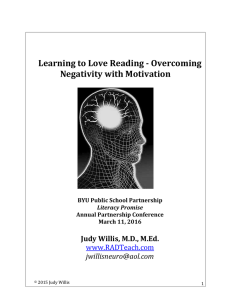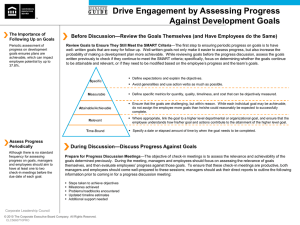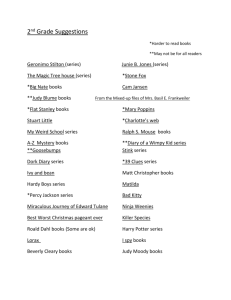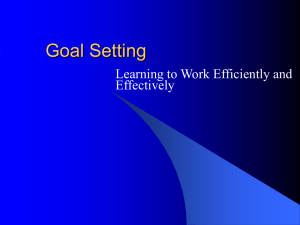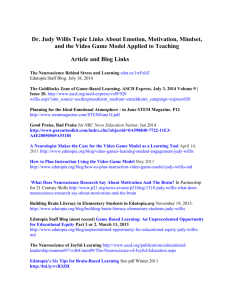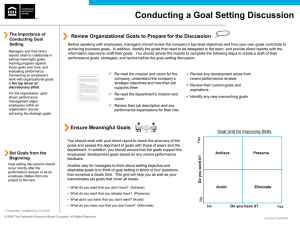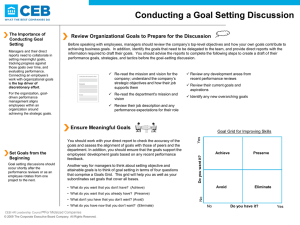achievable challenge
advertisement
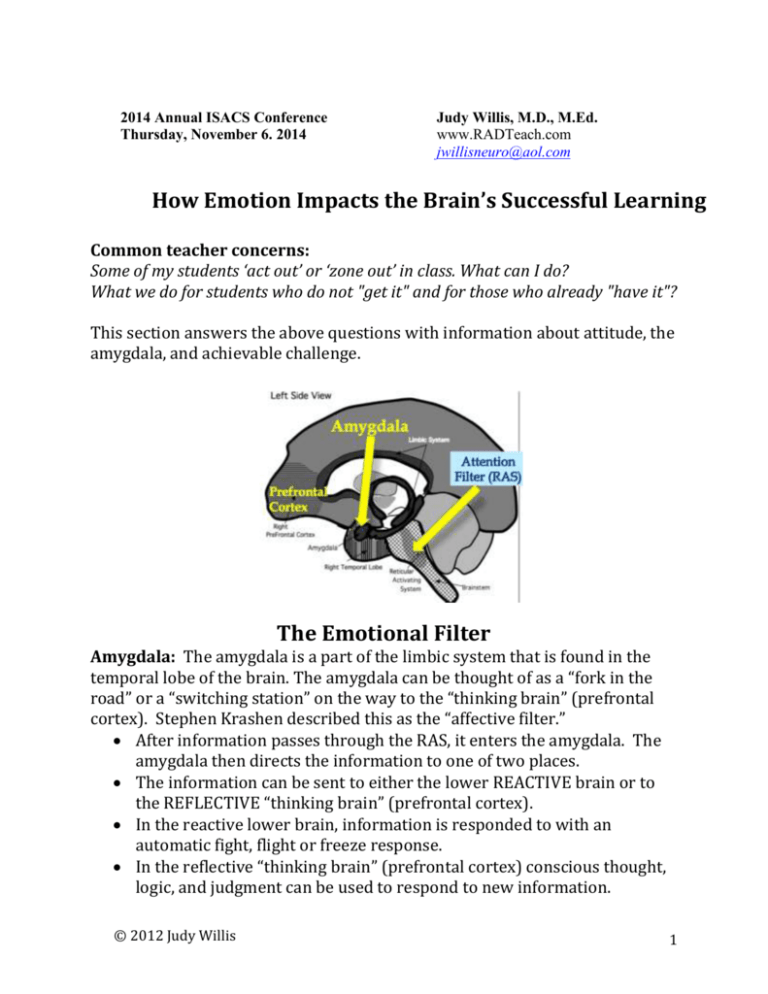
2014 Annual ISACS Conference Thursday, November 6. 2014 Judy Willis, M.D., M.Ed. www.RADTeach.com jwillisneuro@aol.com How Emotion Impacts the Brain’s Successful Learning Common teacher concerns: Some of my students ‘act out’ or ‘zone out’ in class. What can I do? What we do for students who do not "get it" and for those who already "have it"? This section answers the above questions with information about attitude, the amygdala, and achievable challenge. The Emotional Filter Amygdala: The amygdala is a part of the limbic system that is found in the temporal lobe of the brain. The amygdala can be thought of as a “fork in the road” or a “switching station” on the way to the “thinking brain” (prefrontal cortex). Stephen Krashen described this as the “affective filter.” After information passes through the RAS, it enters the amygdala. The amygdala then directs the information to one of two places. The information can be sent to either the lower REACTIVE brain or to the REFLECTIVE “thinking brain” (prefrontal cortex). In the reactive lower brain, information is responded to with an automatic fight, flight or freeze response. In the reflective “thinking brain” (prefrontal cortex) conscious thought, logic, and judgment can be used to respond to new information. © 2012 Judy Willis 1 Information enters the amygdala REFLECTIVE “thinking brain” (prefrontal cortex) *conscious thought, decision making, judgment* REACTIVE lower brain *automatic fight, flight or freeze response* What determines if the amygdala directs information to the reflective “thinking brain” (prefrontal cortex) or to the reactive lower brain? When a person is in a state of high or sustained stress or fear: New information coming through the sensory intake areas of the brain cannot pass through the amygdala’s filter to gain access to the reflective prefrontal cortex. Incoming information is conducted to the lower, reactive brain. The lower, reactive brain has a limited set of behavior outputs: fight, flight, or freeze animals – “act out” and “zone out” in students. Be aware of students who act engaged, but are bored or fearful of failing to achieve highest goals. Students during these states of stress-directed behavior may be misidentified as suffering from disorders i.e. ADHD or being intentionally resistant, stubborn, lazy, or of low intelligence. Stress can reduce the ability of the hippocampus and prefrontal cortex to promote efficient working memory, emotional self-control, and attention focus. Sources of school-related stress: Until the prefrontal cortex (PFC) is more mature, students are more reactive than they are reflective, especially when they perceive stress. Stress comes in many forms for students: © 2014 Judy Willis 2 o The boredom of already having mastery of the information being taught o No personal relevance: not being sufficiently interested in a topic or aware of how the topic relates to a student’s own interests or prior knowledge o Frustration of previous failures, being confused, and falling behind. This is equally stressful for students who get failing grades and for students who repeatedly fail to achieve the goal they (and their parents) set such as #1 in the class or all “A’s” o Fear of being wrong if asked to speak in class, answer questions, or present their work orally o Test-taking anxiety o Physical and language differences o Feeling overwhelmed by work load and unable to organize time to respond to these demands – can be a problem in high achieving students who did not need to learn organizational skills in elementary skills, and are not prepared with these executive functions when the workload increases and planning is necessary. Promoting Transfer of Input through the Emotional Filter Reducing Stress If stress is reduced, and a person is in a relaxed and alert state, information can pass through the amygdala and on to the reflective “thinking brain” (prefrontal cortex) for long-term memory and executive function processing. Students can build skills that allow the prefrontal cortex to over-ride the lower brain’s reactive impulses. • • Participating in new learning requires students to take risks that are often beyond their comfort zones. Steps should be taken to reduce stress during these times. Students can learn how to become aware of their own stress and strategies for relaxing and refocusing. © 2014 Judy Willis 3 Promote Passage through Amygdala to PFC Guide students to: Monitor and control emotions Mindfulness – e.g. reflect before acting on emotions Experience control over sensory responsiveness (e.g. hearing a sound longer) Visualization: imaginary bubble to deflect hurtful actions & words Self-calm (deep-breath, observe themselves from “above”) Reduce Mistake Fear and promote divergent thinking/cognitive flexibility © 2014 Judy Willis 4 Teach Students about Their Brains Learning how the brain processes input helps students develop more reflective PFC control over their reactive lower brains. Related Articles and Websites: How to Teach Students about the Brain link: http://www.radteach.com/page1/page8/page44/page44.html What You Should Know about Your Brain link: http://www.radteach.com/page1/page8/page45/page45.html Animated depiction of neuron network with axons, dendrites, and synapses: http://www.youtube.com/watch?v=frFiBNPVRl4&feature=youtu.be Neuroscience concepts and activities organized by grade level: www.brainfacts.org/About-Neuroscience/Core-Concepts Neuroscience for Kids: activities and interactive learning about the brain: http://faculty.washington.edu/chudler/introb.html#bb Promote Growth Mindsets People with a fixed mindset believe they are born with a certain amount of intelligence and skill, and that is all they will ever have. They believe that once they fail, there is no point in trying again, because they have reached their limit. Those with a growth mindset believe that people are given a certain amount of intelligence and skill, just as they have a certain body type, but that people have the potential to grow their intelligence and skill with hard work, just like a muscle. (Carol Dweck) The Game-Based Model for Mindset, Engagement, and Perseverance The Brain Seeks Patterns and Pleasure © 2014 Judy Willis 5 The Video Game Model in the Classroom Video Game Model Includes: Goal buy-in Individualized achievable challenges Frequent feedback or awareness of incremental goal progress Dopamine-Reward System Drives the Game-Based Model and Builds Motivation and Perseverance Dopamine is usually thought of as a neurotransmitter. Neurotransmitters are chemicals in the brain that transmit signals between neurons (nerve cells). Neurotransmitters allow for information to travel from neuron to neuron throughout the brain. Power of Dopamine Dopamine, when released in amounts that exceed what is needed for carrying signals across synapses, travels throughout the brain. The extra dopamine now acts as a neurochemical with more widespread impact. Increased dopamine is associated with (it both increases and is increased by) pleasurable experiences and the anticipation of pleasurable experiences. Its release also increases focus, memory, and executive function. When dopamine levels go up, the following behaviors are more prominent: • Pleasure • Creativity • Motivation • Curiosity • Persistence and perseverance The following activities increase dopamine levels: • Positive interactions with peers • Enjoying music • Being read to, or told a story or anecdote • Acting kindly • Expressing gratitude © 2014 Judy Willis 6 • • • • • Humor Optimism Choice Movement Feeling the intrinsic satisfaction of accurate predictions and challenges achieved The Components of the Game-Based Model Video and computer games are compelling because they offer individualized achievable challenges and frequent feedback of incremental progress that are physiologically rewarded with the intrinsic satisfaction produced by the brain chemical dopamine. The dopamine rewards come from the brain response of intrinsic satisfaction from making accurate predictions and frequent feedback about achieving challenges. At the outset, a player is presented with a goal. The player begins at level one, and through trial and error (feedback) builds enough skills to ultimately pass level one. The next level challenges the player’s newly developed skills, but ultimately, through sustained effort, practice, and persistence the player succeeds and continues to progress through the levels. The player receives ongoing feedback and the dopamine boosting pleasure of incremental goal progress – reaching the next level. She feels the pride of knowing that her effort caused her success (intrinsic reinforcement). The player then seeks the greater challenge of the next level so she can continue to experience the pleasure of dopamine reward. Goal Buy-in – Personal Relevance With goals designed to connect with students’ interests and authentic performance tasks that they consider relevant, students want the knowledge tools they need to succeed. Students are then in the ideal state for motivated, attentive learning because they want to know what they have to learn. Examples of Personal Goal Relevance Show students how what they are about to study relates to their lives or © 2014 Judy Willis 7 the world around them. Watch a relevant video, such as those relating to math and science found at: http://www.thefutureschannel.com/ Connect a unit with current events Read aloud something curious that relates to the topic at hand Personalize information by connecting the topic to a person or place relevant to students (e.g. book author anecdote). Before a lesson or unit, tell a narrative about the life of the author, scientist, historical figure, or mathematician when he/she was about the age of your students Discuss the “So what?” factor. How the topic connects to the “real world” or to their lives. How are they going to use the new information after you teach it to them (e.g. project, performance task, teach it to younger students)? Your Self-Assessment For Buy-In: How will I promote buy-in? How will I gather and use knowledge about my students to inspire their interests in new learning? How will I relate the value of the learning beyond the classroom? Do I engage students in using what they learn beyond the classroom? Do I use the power of questions and “I wonder…” statements to engage students’ attention and thinking? Do I pursue learning myself so that I model the endless nature of mastering new concepts and abilities? Achievable Challenge Lower the Barrier, Not the Bar What we do for students who do not "get it" and for those who already "have it"? An achievable challenge is one in which a student has the capacity (or skills to develop the capacity) to meet an ambitious goal. As Goldilocks would say, the challenge is “not too hard, not too easy, but just right!” An achievable challenge exists within Vygotsky’s “zone of proximal development”. If a challenge is too easy a student will become bored, which leads to stress, and ultimately disengagement from learning. If a challenge is too difficult a student will experience frustration and hopelessness, which, if sustained or frequent, also leads to excessive stress. However, when facing an achievable © 2014 Judy Willis 8 challenge that is just within their reach, students avoid the detrimental states of stress, and the amygdala is able to pass information to and from the prefrontal cortex. Achievable challenge lowers stress by reducing boredom and frustration and motivating perseverance and effort. One way of helping students to develop a growth mindset is to provide them with achievable challenges and alert them to their progress. Students are most motivated by the expectation of a dopamine reward when they learn at their individualized levels of achievable challenge. Providing students with achievable challenges reduces the reactive states resulting from the stress of boredom or frustration and promotes the intrinsic motivation of the video game model. In the actual video game, players are playing in their personal zone of achievable challenge at most times. Although this individualization is not possible for all students, options will increase as technology provides resources for online learning “games”, lectures (flipped classroom), and enrichment opportunities for students already at mastery. While some students build basic math facts within their personal zone of achievable challenge with well-designed, interactive online learning programs, their teacher can guide others on inquiry projects and collaborations. Frequent and ongoing assessments would need to guide the setting and resetting of instruction and skill practice throughout learning with support provided to sustain the student’s efforts to overcome setbacks and obstacles and to provide the motivation of challenge when mastery is achieved. What can teachers do to enable students to work within their achievable challenge level? Lower the barriers, not the bar: Communicate high expectations for all students and provide differentiation and support so students can achieve their goals. At the start of a unit clearly define the learning goals, success criteria, and types of assessments. Take time to provide examples of how students’ interests will be incorporated into their learning and how their strengths will be included in the assessments. © 2014 Judy Willis 9 • • • • Pre-assessments Activate prior knowledge Offer flexible groups Multiple options to build foundational knowledge e.g. videos, websites, different levels of reading for content Use scaffolding and enrichment Frequent, ongoing formative assessments with both corrective and progress feedback Pre-Assessment for Achievable Challenge and Prior Knowledge Activation In order to teach at a level that includes achievable challenge for all students, it is necessary to identify gaps in foundational knowledge. These gaps can be the result of a number of factors such as newly arrived English language learners, transfers from schools that do not use the same progression of concept building, reading difficulties, or a system of summative assessments not given until after units are taught without the corrective feedback. Without corrective feedback, students will not develop the accurate neural networks needed to accommodate new learning. Pre-assessments are self-corrected, non-credit quizzes. Pre-assessments can: Alert both the student and the teacher to what the student already knows about a topic. With this information the teacher can provide early remediation if a student is missing some foundational skills that will be needed for the topic. The teacher can also develop plans for enrichment if students already have mastery. Provide a preview of the upcoming key concepts. Neurologically, this stimulates the circuits of any related prior knowledge the students have. Activating this knowledge makes it easier for students to understand and remember the new information. By writing down what they think the correct answer will be they have more buy-in when listening to the correct answers you provide following the pre-assessment. Provide timely corrective feedback by going over all of the answers immediately after the pre-assessment. Students should correct their own quizzes (in another color) to increase attention and early rewiring © 2014 Judy Willis 10 of incorrect prior knowledge. Provide a study guide for test review Scaffolding/Enrichment Key vocabulary lists with pictures and definitions, vocabulary pantomime Manipulatives for addressing misunderstandings in math Reading comprehension strategies to help all levels of readers read appropriately challenging texts (variety of levels of reading and alternatives such as video and audio sources of foundational information). These are explained in more detail below such as learning self-questioning strategies such as turning subheadings of texts into questions to answer as the chapter is read, jigsaw, “talk back to text”, three color highlighting Give students the opportunity to discuss ideas before offering responses to questions (pairs or small groups). This is especially useful for students developing mastery of English as a new language or in foreign language classes before they respond orally in the foreign language. Increase reading comprehension of challenging texts with the following strategies: 1) “Talking Back to the Text” is an interactive reading strategy that helps students become personally engaged with what they read. Students begin by writing questions and prompts on post-it notes or other small papers that they can insert into their text. Some questions are prediction questions the student will answer before reading while others will be responded to while the student is reading. Before reading the students writes and answers prediction questions: o I think you’ll be telling me… o I already know things about YOU so I predict..... During reading students can complete the following questions or prompts: o You are similar to what I have learned before, because you remind me of... o I would have preferred a picture of...(or sketch/download their own) o I didn’t know that and I find it interesting because … o I disagree because… © 2014 Judy Willis 11 o This is not what I expected which was… o This gives me an idea for … o I want to know more about this than you have to offer. I’ll find out by… o I have a different way of interpreting this information, which is… o I won’t let you get away with this statement, so I’ll check your source by …… o This could be a clue to help me answer the “Big Question” because… o I think this will be on the test because… 2) “Highlighting with Three Colors” 3) Improve reading comprehension with the “think-aloud” strategy and self questioning. At home students should say out loud what they are thinking while reading, solving a problem, or answering questions. You can model this while reading a text in the classroom. Pause to illustrate to your students what you are thinking as you are reading the text. Flipped Classrooms The flip in “flipped classrooms” means that students are assigned an instructional video to watch before the teacher “teaches” the topic in class. Students learn through a variety of instructional methods such as videos created by their classroom teachers, Khan Academy videos, and other online activities suited to their levels. They come to class with a knowledge that they can then apply to classroom activities and projects. In the classroom, students can then work in flexible small-groups with teachers or on collaborative group projects where students’ unique strengths are highlighted. If core skills can be learned at an individualized pace, especially using computer programs that adjust to the needs of the individual student, or through tailored videos, teachers can make a greater impact on student learning. Teachers can: o Be creative with less rigid prescribed whole class instruction o Demonstrate why subjects are meaningful and exciting o Provide more mentoring and guiding o Accumulate insight about where students are so they can teach at skill levels Class time becomes available for: © 2014 Judy Willis 12 o Development of concept-level understanding o Remediation and enrichment o Inquiry, discussions, projects Peer Tutoring for Achievable Challenge Benefits for Tutors o Increases mastery and long-term concept memory of academic skills o Improves self-esteem and self-confidence o Improves students' executive functions For Those Being Tutored o Individual instruction, tailored to individual learning styles and ability level o Increased feedback for motivation and growth mindset Choice of products to demonstrate ongoing understanding and of mastery: Expository: the responsibilities and qualities of Supreme Court justices Computer/Technology: redesign educational web sites about the Supreme Court targeting younger students including duties and qualifications Analytical task: create a flow chart, web, or other diagram to illustrate and explain the relationships among a justice’s duties, term length, and qualifications Creative task: write a script for a scene involving senators questioning a nominee for the Supreme Court during a hearing. One senator’s questions reveal his misconceptions about the duties, term length, and qualifications of a justice. Another senator skillfully questions the nominee to correct the misconceptions through his clever questioning. Variety of assessment modalities, including opportunities to demonstrate understanding through their strengths, their effort, and perseverance Online Learning Games for Scaffolding and Enrichment: These can be used for skill practice and feedback at the student's individual level of readiness Edutopia links to my blogs about On-Line Learning Games for foundational knowledge and practice: http://www.edutopia.org/technology-integration-research-evidencebased-programs Online Learning Game Resources: Graphite is a free service listing many apps, games, websites, and digital curricula. http://www.graphite.org. © 2014 Judy Willis 13 EdSurge Product Reviews https://www.edsurge.com/p ClassroomWindow classroomwindow.com Ednak: peer-reviewed tools of education technology http://www.ednak.org/ Budget Hero (http://www.graphite.org/website/budget-hero) is an online game for building foundational knowledge about the United States and financial policy for students in grades 9-12. The website offers over thirty outside resources about budget, policy, and government information. The learning play offers authentic performance tasks about budgetary expansion, taxes and cuts. Students get feedback about the results of their actions. Newsela.com: Archive of more than 500 articles each at five reading levels, organized by category and reading standard. Students take quizzes and view progress Resources for Learning Differences: Instructional videos for educators/parents: http://www.uctv.tv/health/ University of California's Health Channel features videos about e.g. autism, brain injury, mind-body connection, nutrition, child development, sleep disorders, stress, teen health, and brain development Learning disability resource recordings: SERU (Special Education Resource Unit) website. Scroll all the way down to the bottom of the page to find the recordings. http://web.seru.sa.edu.au/Workshops.htm Frequent Formative Assessment, Ongoing Feedback, & Awareness of Incremental Progress Students will experience the intrinsic pleasure of incremental progress if they experience ongoing formative assessments with feedback, reteaching, opportunities for self-corrections, and metacognition. With this exposure students can build understanding and progress at achievable challenge levels of success. In general we experience an intrinsic reward when we realize that we are making progress due to our practice and effort. Even noticing small changes can be helpful. For example, having students keep a graph of how their reading fluency improves depending on how much they practice can be very motivating. The game-based model gives students the opportunity to recognize both the intrinsic pleasure of incremental progress (“I got it” experience) and the cause/effect that putting in effort towards practice and review brings them progressively closer to their goals. © 2014 Judy Willis 14 Students who feel alienated in school need additional support to regain their confidence and feel motivated towards reaching a challenging goal. If struggling academically has always been a source of disappointment for them, help students recall when they have been successful towards reaching a goal (e.g. music, sports, art, making friends, cooking something new, etc.). Exit Slips for Formative Feedback: Before the lesson ends students can respond to selected prompt (also see dend-write prompts): “One thing I learned today is…” “One thing that surprised me today was…” “Something I’d like to find out more about is…” AND: “Something that confused me is…” OR: “A question I have is…” Frequent feedback: Look for Patterns of Error in Student Work Students’ misconceptions tend to be shared and produce a consistent pattern of errors. Identify these misconceptions from previous years, class discussions, and students’ errors on homework and quizzes. Common misunderstandings without concept understanding Misconception references from AAAS Science Assessment website http://assessment.aaas.org/pages/references Analytic Rubrics for Incremental Progress Awareness Analytic rubrics are consistent with the amygdala positive benefits of the video game model of achievable challenge and incremental progress. Rubrics allow all students to: Understand what is expected and how they can achieve steps of incremental progress along the way toward overall goal Experience the choice (a dopamine booster) of achievable challenge – where they will focus effort Rubric Generator Websites http://www.teachervision.fen.com/teaching-methods-andmanagement/rubrics/4524.html#ixzz1d2xZeJck http://www.teach-nology.com/web_tools/rubrics/ http://rubistar.4teachers.org/index.php http://myt4l.com/index.php?v=pl&page_ac=view&type=tools&tool=rubricmaker © 2012 Judy Willis 15 Audio feedback can also be left in documents that are turned in through turnitin.com Developing Awareness that Effort Increases Goal Progress in Video Game Model Conferences Portfolios Metacognition/class discussion Rubrics with examples of different levels (e.g. benchmark examples) Student-lead conferences Effort=Progress to Goal Graphs Help your students use graphs to see the connection between their work, practice, effort, and their progress. Goals can range from time spent preparing for tests, number of answers correct on spelling tests, to progressing up rubric levels of proficiency in any subject. Help students build their own goal-directed behavior patterns by selecting the progress points they want to achieve on route to the final goal. Use small post-its or write in pencil when they believe they can reach each goal subdivision. As they progress they examine the accuracy of their projections and revise subsequent goal achievement dates and strategies accordingly. Sample graphs: www.onlinecharttool.com Emotion Summary • Emotions influence where new information is processed in the brain. For learning to become memory it must be directed through the emotional filter (amygdala) along the route to the reflective, higher brain – the prefrontal cortex. • High stress reduces information flow through the amygdala (emotional filter) to and from the cognitive/reflective brain (Prefrontal Cortex – PFC). • During high stress, the survival instinct takes reactive control and responses are directed by the involuntary “lower” brain with output limited to fight/flight/freeze responses (act out/zone out). • The mammalian brain is wired to withhold effort when experience predicts a low probability of success. © 2012 Judy Willis 16 • The human brain can be “rewired” to reverse effort withholding when instruction follows the video game model: buy-in, achievable challenge, and frequent feedback of incremental goal progress. • The power behind the video game “model’s” impact on motivation and perseverance is the intrinsic reinforcement of the dopamine-reward response to accurate predictions and feedback of challenges achieved. • Goals that are clear, personally relevant, and believed to be achievable challenges are needed to promote brain “buy-in” and effort when previous efforts have not yielded goal success. In an amygdala-positive learning environment we see evidence of active learning and participating: o Students observing and noticing with focused attention (without act out/zone out) o Students discovering, thinking and questioning o Students who are engaged, motivated, interested, self-sustained learners To promote a positive attitude so that information gets to the prefrontal cortex (PFC): Use curiosity promoting questions/demonstrations and make learning personalized for “buy-in” Have students work in their zone of “achievable challenge” Teach students how to recognize their progress towards a goal Questions to Consider in Planning Units and Instruction in the Video Game Model How will students buy in from interest and relevance? What hooks will connect them from the beginning and what will sustain their interest in learning and understanding (predictions, audience relevance) How will I sustain awareness of big ideas revisit them throughout (headlines, mind maps) How will I use formative assessments to gain feedback about students developing understanding, emotional comfort, and my success? © 2012 Judy Willis 17 How will I provide incremental progress feedback for students? Start with One Student Teaching isn’t brain surgery – It’s Harder Start with your achievable challenge – you need the validation of success to keep your dopamine-effort up Select one student where your efforts to “individualize” will have evident impact Be alert for improvements: ambient classroom noise, tardiness, more participants in discussions, more good questions, less disruptive classroom behavior WEBLINKS Website showing multiple examples of curriculum contents adapted to the video game model: http://ierg.net/lessonplans/unit_plans.php KWL Charts at readwritethink These free downloadable K-W-L Charts track what a student knows (K), wants to know (W), and has learned (L) about a topic, and can be used before, during, and after units of study or research projects. http://www.readwritethink.org/classroom-resources/printouts/chart-a30226.html Sample RAD lessons/units at ASCD edge Website http://edge.ascd.org/service/searchEverything.kickAction?keywords=lesson+plans&inclu deBlog=on&as=127586&sortType=relevance © 2012 Judy Willis 18 © 2014 Judy Willis 19
